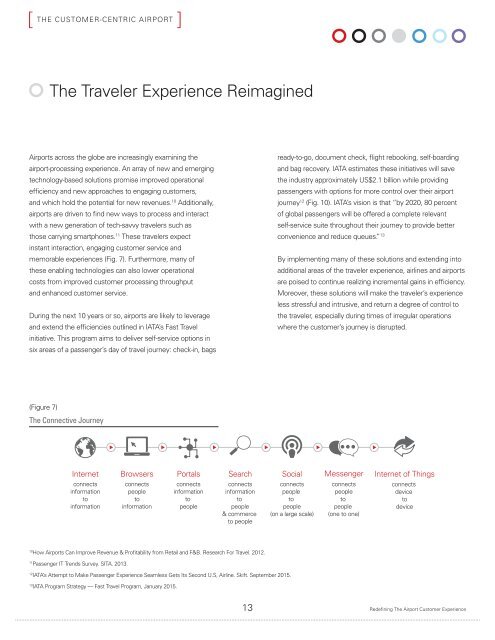WHITEPAPER THE CUSTOMER-CENTRIC AIRPORT
SabreSonic_The_Customer_Centric_Airport_Final
SabreSonic_The_Customer_Centric_Airport_Final
You also want an ePaper? Increase the reach of your titles
YUMPU automatically turns print PDFs into web optimized ePapers that Google loves.
<strong>THE</strong> <strong>CUSTOMER</strong>-<strong>CENTRIC</strong> <strong>AIRPORT</strong><br />
[<br />
[<br />
The Traveler Experience Reimagined<br />
Airports across the globe are increasingly examining the<br />
airport-processing experience. An array of new and emerging<br />
technology-based solutions promise improved operational<br />
efficiency and new approaches to engaging customers,<br />
and which hold the potential for new revenues. 10 Additionally,<br />
airports are driven to find new ways to process and interact<br />
with a new generation of tech-savvy travelers such as<br />
those carrying smartphones. 11 These travelers expect<br />
instant interaction, engaging customer service and<br />
memorable experiences (Fig. 7). Furthermore, many of<br />
these enabling technologies can also lower operational<br />
costs from improved customer processing throughput<br />
and enhanced customer service.<br />
During the next 10 years or so, airports are likely to leverage<br />
and extend the efficiencies outlined in IATA’s Fast Travel<br />
initiative. This program aims to deliver self-service options in<br />
six areas of a passenger’s day of travel journey: check-in, bags<br />
ready-to-go, document check, flight rebooking, self-boarding<br />
and bag recovery. IATA estimates these initiatives will save<br />
the industry approximately US$2.1 billion while providing<br />
passengers with options for more control over their airport<br />
journey 12 (Fig. 10). IATA’s vision is that “by 2020, 80 percent<br />
of global passengers will be offered a complete relevant<br />
self-service suite throughout their journey to provide better<br />
convenience and reduce queues.” 13<br />
By implementing many of these solutions and extending into<br />
additional areas of the traveler experience, airlines and airports<br />
are poised to continue realizing incremental gains in efficiency.<br />
Moreover, these solutions will make the traveler’s experience<br />
less stressful and intrusive, and return a degree of control to<br />
the traveler, especially during times of irregular operations<br />
where the customer’s journey is disrupted.<br />
(Figure 7)<br />
The Connective Journey<br />
Internet<br />
Browsers<br />
Portals<br />
Search<br />
Social<br />
Messenger<br />
Internet of Things<br />
connects<br />
information<br />
to<br />
information<br />
connects<br />
people<br />
to<br />
information<br />
connects<br />
information<br />
to<br />
people<br />
connects<br />
information<br />
to<br />
people<br />
& commerce<br />
to people<br />
connects<br />
people<br />
to<br />
people<br />
(on a large scale)<br />
connects<br />
people<br />
to<br />
people<br />
(one to one)<br />
connects<br />
device<br />
to<br />
device<br />
10<br />
How Airports Can Improve Revenue & Profitability from Retail and F&B. Research For Travel. 2012.<br />
11<br />
Passenger IT Trends Survey. SITA. 2013.<br />
12<br />
IATA’s Attempt to Make Passenger Experience Seamless Gets Its Second U.S, Airline. Skift. September 2015.<br />
13<br />
IATA Program Strategy — Fast Travel Program, January 2015.<br />
13<br />
Redefining The Airport Customer Experience


